Dead Sperm Whale On North Shore Towed Out To Sea
Jason Graziadei •
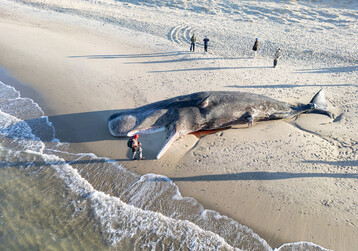
The dead sperm whale that washed up on Nantucket's north shore on Sunday was towed out to sea on Friday by the tugboat Lucinda Smith following an examination by marine mammal experts.
The carcass of the 50-foot male sperm whale weighs an estimated 104,000 pounds, or 52 tons, and has been the talk of the town since it washed ashore last weekend at the popular 40th Pole beach.
Sperm whales, which were hunted by Nantucketers for their spermaceti oil all over the world during the 19th century, are the largest toothed predator on Earth. The species inhabits deep oceanic waters and is classified as endangered, so it’s a rare occurrence to spot one - alive or dead.
The one that washed up at 40th Pole was the first sperm whale stranding on Nantucket since 2002.
"It certainly doesn't happen every day," Gibson said to the Select Board on Wednesday as she outlined the town's plan to tow the sperm whale carcass offshore.
On Friday, with an assist from Trevor Barrett’s excavator on the sand, a small vessel was able to pull the whale carcass off the beach and bring it to the tugboat Lucinda Smith, which was waiting about half a mile offshore. Both vessels are operated by the Robert B. Our Co.
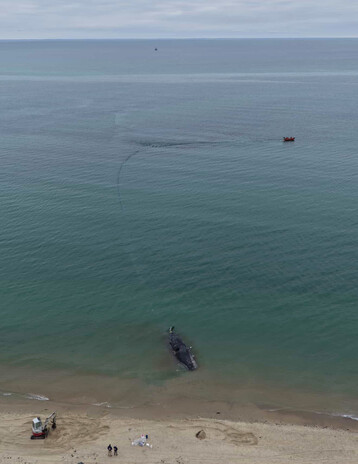
The crew of the Lucinda Smith then transported the whale approximately 50 miles east to dispose of the carcass and ensure it doesn’t wash up again.
The tow operation came immediately after the whale was examined by marine mammal experts from the International Fund For Animal Welfare and the New England Aquarium, who conducted a window exam to learn more about the deceased cetacean and potentially determine its cause of death.
IFAW animal rescue veterinarian Dr. Sarah Sharp explained how the team completed what is known as a “window exam,” which allowed them to take samples and inspect some of the whale’s major organs. While they had hoped to conduct a full necropsy, that would have required transporting the 104,000-pound carcass to another location, and it was determined it was simply too large.
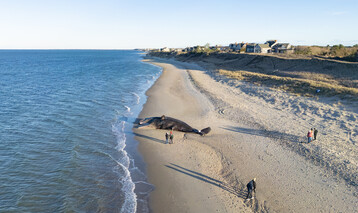
While marine mammal officials had hoped to transport the dead whale to a secure location on land to perform a full necropsy that could determine the cause of death, they ultimately determined the carcass was simply too large to be removed from the beach.
Last Wednesday, a small crowd gathered at 40th Pole to watch as representatives from NOAA and the Massachusetts Environmental Police worked on the sperm whale carcass to remove its lower jaw. This was done, Murphy said, to prevent anyone from removing its valuable ivory teeth to keep as a souvenir or to sell on the black market.
"They (NOAA Office of Law Enforcement) keep it in custody," Murphy said of the jawbone and teeth. "If stuff like that gets onto the black market, it only creates more risk of poaching endangered animals."
Sperm whales are protected under both the Marine Mammal Protection Act and the Endangered Species Act, making it illegal to take ivory teeth from their carcasses. The federal laws aim to discourage the commercial trade of ivory and prevent further harm to endangered species that may be targeted for their teeth or tusks.
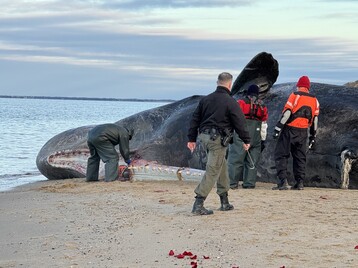
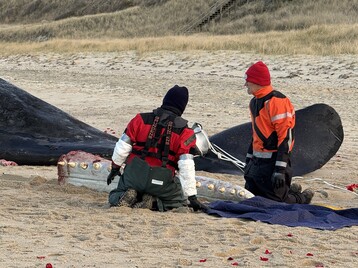
Before workers used a chainsaw and large fillet knives to remove and cut the jawbone into pieces, a short memorial ceremony was held on the beach to honor the dead whale. Island resident Annie Backus even brought rose petals to sprinkle on the beach around the carcass.
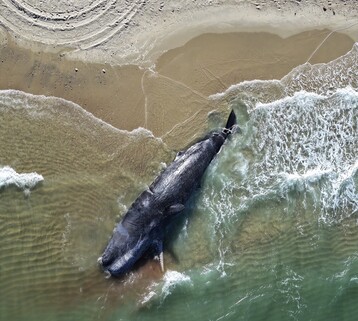
It is the first sperm whale to wash ashore on Nantucket since June 2002, when a deceased sperm whale was discovered at The Galls near Great Point. It was towed by a tugboat to New Bedford, and its skeleton now hangs in the New Bedford Whaling Museum. On Nantucket, the more well-known sperm whale stranding occurred four years earlier on New Year's Day in 1998, when a 46-foot male sperm whale washed ashore and died at Low Beach. Its skeleton now hangs in the Nantucket Historical Association's Whaling Museum on Broad Street.
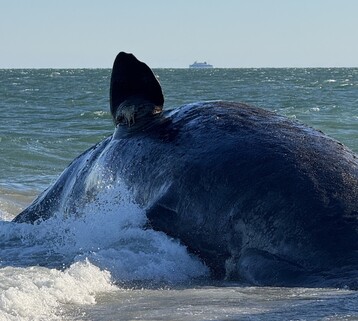
The beached sperm whale has not only captured the attention of the island community, but it has also been the subject of coverage by regional and national media outlets. The Boston Globe, CBS News, and the New York Times have all covered the story, and last night CNN used Nantucket Current's footage in its own report on the whale: